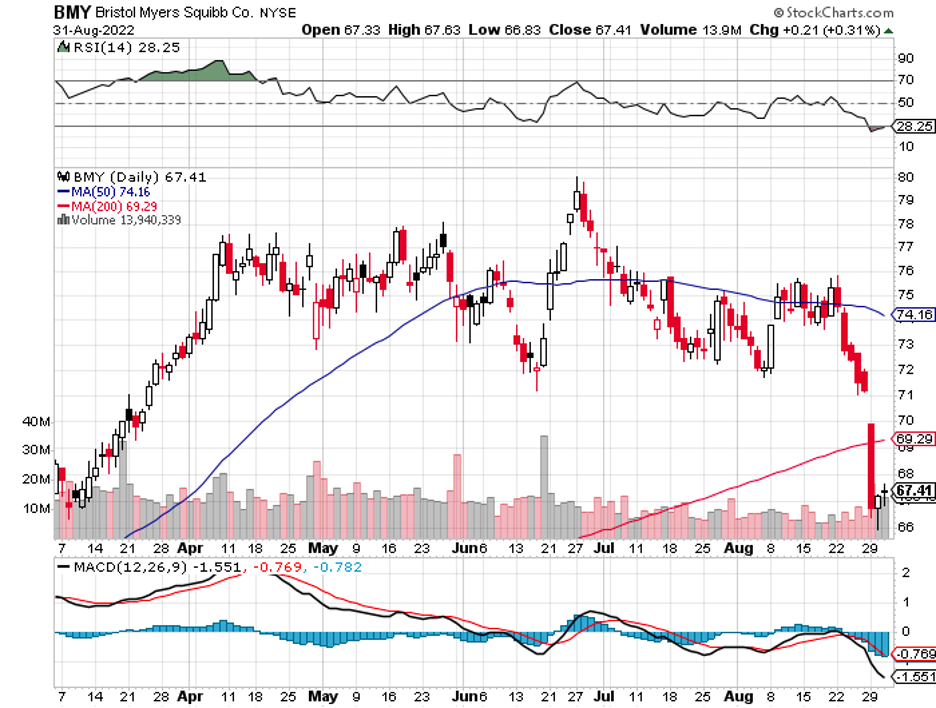Sometimes the market overreacts, and it presents a buying opportunity for savvy investors. This is what happened with Bristol Myers Squibb (BMY).
Investors pulled back on BMY shares following mixed results from the Phase 2 trials of Milvexian, a stroke therapy the biopharmaceutical giant is developing with Johnson & Johnson (JNJ).
This treatment works as an anticoagulant formulated to prevent secondary strokes that usually occur after an ischemic stroke.
Ischemic strokes are the most common kind of strokes, triggered when a blood clot blocks an artery heading to the brain.
In its trial, Milvexian showed that it was able to lower the recurrence of ischemic strokes by 30% among patients who exhibited symptoms.
Unfortunately, it wasn’t able to show any effect on the smaller lesions typically detected only via MRIs. This is where the problem lies since the latter was part of the predefined endpoints when the trials started.
So, in terms of reducing symptomatic stroke, Milvexian’s results were “very positive.” But if you consider all the factors, then you get mixed data.
The underwhelming results of Milvexian’s Phase 2 trials led to a 5.5% fall in BMY’s shares, clearly demonstrating the erosion of investor confidence going into Phase 3.
What does this mean?
Milvexian was designed to become the successor of BMY’s mega-blockbuster Eliquis. BMY’s shares are declining because of the fear over the effectiveness of the company’s strategy to power through upcoming patent losses.
Despite the setback, BMY and JNJ aren’t giving up on the treatment. Apart from the 30% risk reduction it offers patients, Milvexian has an impressive safety profile. Based on these results alone, the companies still consider the candidate a good product.
Moreover, the results do not appear to be affecting the overall performance and strategy of the company. Minor adjustments simply need to be made.
The pharma giant’s recent quarter report disclosed revenue of $11.9 billion, which climbed 2% year over year. Within its US market, BMY’s revenue grew by 12%.
The company is also continuously innovating. In early 2022, the FDA approved a new cancer treatment it developed, estimated to rake in $4 billion in peak sales.
It’s also consistent in terms of delivering results. BMY has been generating over $11 billion in revenue quarterly, with profits reaching 14% of sales during those periods.
These sound financials place BMY in a great position to expand and pay out its dividend, which is at 2.9% to date.
Year to date, BMY has been consistently and soundly beating the general markets. It has been up 19% compared to the 10% fall of the S&P 500 as of late.
Aside from developing potential successors, BMY has also been active in acquiring assets. Recently, it shelled out $13 billion to buy MyoKardia.
The deal enabled BMY to gain access to Camzyos, a prescription medicine used to treat adults with a heart condition called symptomatic obstructive hypertrophic cardiomyopathy.
Camzyos recently gained approval and is estimated to reach $4 billion in peak sales annually.
BMY also recently acquired Turning Point Therapeutics for $4.1 billion to gain access to Repotrectinib, which is pegged as the next-generation oral treatment for lung cancer.
Given the drug’s data, it has the potential to competitively go head-to-head against Roche’s (RHHBY) Rozlytrek and rake in $1.5 billion in peak sales.
So, should investors start buying BMY shares following the clinical setback with Milvexian?
While Milvexian isn’t shaping up as the heir apparent for Eliquis, BMY still has a broad pipeline and portfolio of high-value treatments in the market and is under development.
In other words, BMY could easily shake off this setback. That means savvy investors may want to look into the stock and take advantage of this momentary weakness in the Big Pharma’s stock price.
After all, BMY is an excellent drugmaker that investors can rely on for long-term growth and dividend income.


